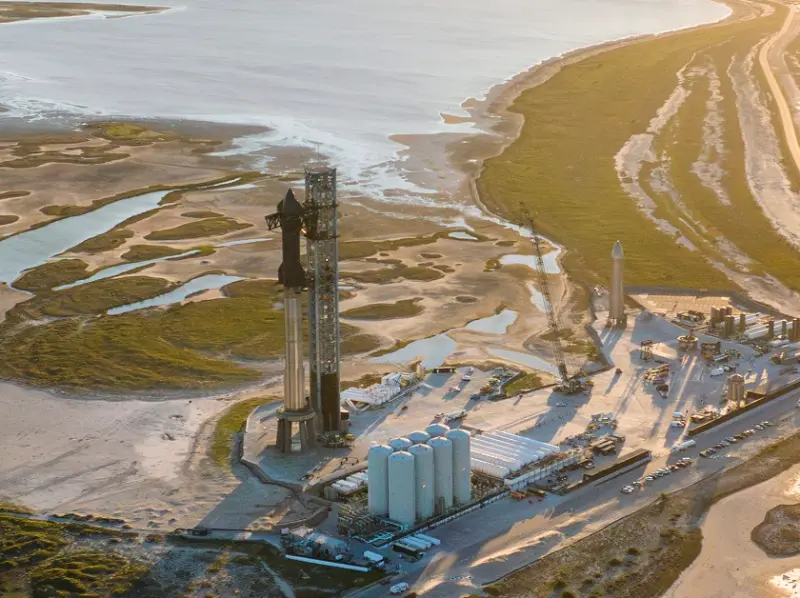
SpaceX has once again pushed the boundaries of space exploration with its latest Starship rocket launch, setting a new standard for reusable rocket technology. On October 13th, 2024, the world watched as the 400-foot-tall Starship vehicle soared into the sky from the Boca Chica launch site in Texas. But what truly captivated engineers, space enthusiasts, and the general public was not just the launch itself—but the historic return of the Super Heavy booster, caught mid-air by SpaceX’s innovative “chopstick” arms. This monumental achievement signals a massive leap forward in reusable rocket technology and brings SpaceX closer to its dream of making space travel more accessible and sustainable.
Table of Contents
A Bold and Unprecedented Feat
SpaceX has never shied away from ambitious goals, and this recent mission is a testament to that. The company has been working tirelessly to perfect its Starship rocket, a vehicle designed to carry astronauts and cargo to the Moon, Mars, and beyond. The latest test flight marked the fifth time the Starship vehicle had taken off. But this time, SpaceX aimed higher, quite literally.
For the first time ever, SpaceX planned to catch the first-stage booster of the rocket—known as the Super Heavy—directly on the launch tower. This booster is equipped with 33 methane-fueled engines and is responsible for propelling the second stage, or “Ship,” into space. Rather than letting the booster land on a platform in the ocean, as SpaceX has done with its Falcon 9 rockets, the company attempted to catch it with mechanical arms attached to the tower, a structure dubbed “Mechazilla.”
This maneuver seemed like something out of science fiction, but SpaceX nailed it. About seven minutes after liftoff, the Super Heavy booster made its way back to the launch site, slowed by its Raptor engines, and gently floated into the waiting arms of the tower. Cheers erupted from SpaceX’s mission control, with employees calling the moment “one for the history books.”
Why Reusability Matters
So why is this booster catch such a big deal? In short, reusability is the key to making space travel more affordable and sustainable. SpaceX has long been focused on reducing the cost of launching rockets, and reusable components are a major part of that strategy. Traditionally, rockets are single-use vehicles. They launch, complete their mission, and then burn up in the atmosphere or crash into the ocean, never to be used again. This model is both wasteful and expensive.
By reusing rockets, SpaceX can drastically cut down on the cost of each mission. The Falcon 9, SpaceX’s smaller rocket, has already proven this model to be viable. Over the past nine years, SpaceX has successfully landed and reused Falcon 9’s first-stage boosters multiple times, saving millions of dollars. However, the Starship vehicle represents a whole new level of scale. Its Super Heavy booster is significantly larger and more powerful, designed to carry heavy payloads and human crews to deep space.
Catching the booster with mechanical arms, rather than landing it on a platform, makes the process even more efficient. It eliminates the need for specialized landing gear on the booster itself and reduces the wear and tear that occurs during hard landings. More importantly, it allows for a quicker turnaround between launches. The goal is to have rockets that can be relaunched within hours or days, not weeks or months.
The Bigger Picture: Starship’s Role in Space Exploration
The successful launch and catch of the Super Heavy booster are just one part of SpaceX’s broader vision for space exploration. The second stage of the rocket, simply called “Ship,” is designed to carry astronauts and cargo to destinations far beyond Earth’s orbit. During this test flight, the Ship separated from the booster about two minutes after liftoff and continued its journey towards space. After a successful splashdown in the Indian Ocean, SpaceX hit two major objectives for this mission: landing both the booster and the Ship.
Starship isn’t just another rocket—it’s the cornerstone of SpaceX’s plan to make humanity a multi-planetary species. Elon Musk, SpaceX’s founder and CEO, has been vocal about his goal to send humans to Mars, and the Starship system is central to that mission. NASA has already awarded SpaceX a $2.8 billion contract to develop Starship as a lunar lander for its Artemis missions, which aim to return astronauts to the Moon by 2026. With the success of this latest launch, SpaceX is one step closer to turning those dreams into reality.
Challenges Along the Way
Of course, the road to success hasn’t been without bumps. Just eighteen months ago, the first Starship launch ended in an explosion shortly after liftoff. SpaceX’s development approach is all about rapid iteration, testing, and learning from failures. Instead of waiting for perfection, the company launches early, collects data, and makes improvements. This trial-and-error method, while sometimes costly, has allowed SpaceX to innovate at a much faster pace than traditional aerospace companies.
One of the biggest challenges SpaceX faces moving forward is regulatory. The Federal Aviation Administration (FAA) has strict guidelines that SpaceX must adhere to for every launch. Recently, there have been public disagreements between Elon Musk and the FAA regarding licensing and environmental concerns. As rocket launches increase in frequency, the environmental impact—especially in terms of emissions—will need to be closely monitored.
What’s Next for SpaceX?
With the successful catch of the Super Heavy booster, SpaceX is now focused on refining the Starship system even further. The company’s goal is to make space travel as routine as commercial air travel. In the near term, SpaceX will continue testing Starship, making improvements to its systems, and preparing for crewed missions to the Moon and Mars.
The latest Starship launch is proof that SpaceX is getting closer to that goal. Reusable rockets, capable of rapid redeployment, will revolutionize the way we explore space. This isn’t just about saving money—it’s about making space accessible to more people and opening the door to deeper exploration of our solar system.
As SpaceX continues to break new ground, one thing is clear: the era of reusable rockets is here, and it’s only just beginning. With each successful test, the dream of making humanity a multi-planetary species moves from science fiction to reality. And thanks to SpaceX’s Starship, that future looks closer than ever before.








